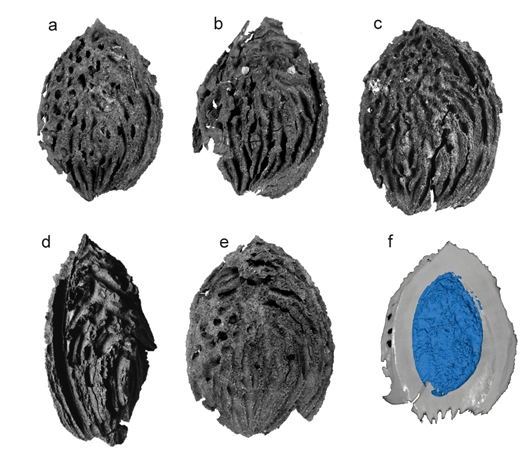
Prunus persica (peach) is an economically important deciduous tree in the Rosaceae family that produces 20 million tons of fruit per year. China has a long history of peach cultivation known from both historical and archaeological evidence. So far, the oldest evidence for the peach has been Chinese archaeological records dating to 8000–7000 BP. Despite the significant fossil record of Rosaceae and the genus Prunus, the origins of the peach and its unique features remain unknown.
Prof. ZHOU Zhekun’s team of Xishuangbanna Tropical Botanical Garden (XTBG) and their collaborators found eight fossil peach endocarps near North Terminal Bus Station of Kunming, Yunnan Province, southwestern China (25° 06'19.77"N, 102°45'52.45"E) in 2010. They found that the morphological characters of the fossil endocarps were identical to modern peaches. The discovery of the oldest fossil peaches provided important evidence for the origins and evolution of the modern fruit.
The well-preserved specimens showed large, single-seeded endocarp, elliptic shape, and deep vascular bundle canal along the edge of the dorsal side. The morphological characters assigned them to the genus Prunus. The most distinctive features of peaches seen in the fossil endocarps were the large size, apiculate apex, presence of both pits and furrows on the exterior surface, and typical linear striations on the interior endocarp surface. Thus, the well-preserved fossil endocarps showed no differences from the living peach. The researchers proposed the new species name, Prunus kunmingensis, to provide an unambiguous epithet for the fossils in the absence of a whole-plant reconstruction.
The well-preserved specimens comprised the earliest record of peach, from the late Pliocene (i.e., by ca. 2.6 million years ago), as well as the only occurrence that predated archaeological evidence. Prunus kunmingensis demonstrated the early presence of peach in southwestern China and dramatically increased the region’s established significance for the evolutionary origins and cultivation history of the fruit.
The study entitled “Peaches Preceded Humans: Fossil Evidence from SW China” has been published in Scientific Reports.
Contact:
ZHOU Zhekun, Ph.D Principal Investigator
Key Laboratory of Tropical Forest Ecology, Xishuangbanna Tropical Botanical Garden, Chinese Academy of Sciences,
Mengla, Yunnan 666303, China
Tel: 86-871-65109223
E-mail: zhouzk@xtbg.ac.cn

(a–e) KUN PC2015001-KUN PC2015005. (f) CT scan showing longitudinal section and seed. (Image by SU Tao)

Anicient Human Picks Peaches (Image by Rebecca Wilf)

86-10-68597521 (day)
86-10-68597289 (night)

86-10-68511095 (day)
86-10-68512458 (night)

cas_en@cas.cn

52 Sanlihe Rd., Xicheng District,
Beijing, China (100864)

